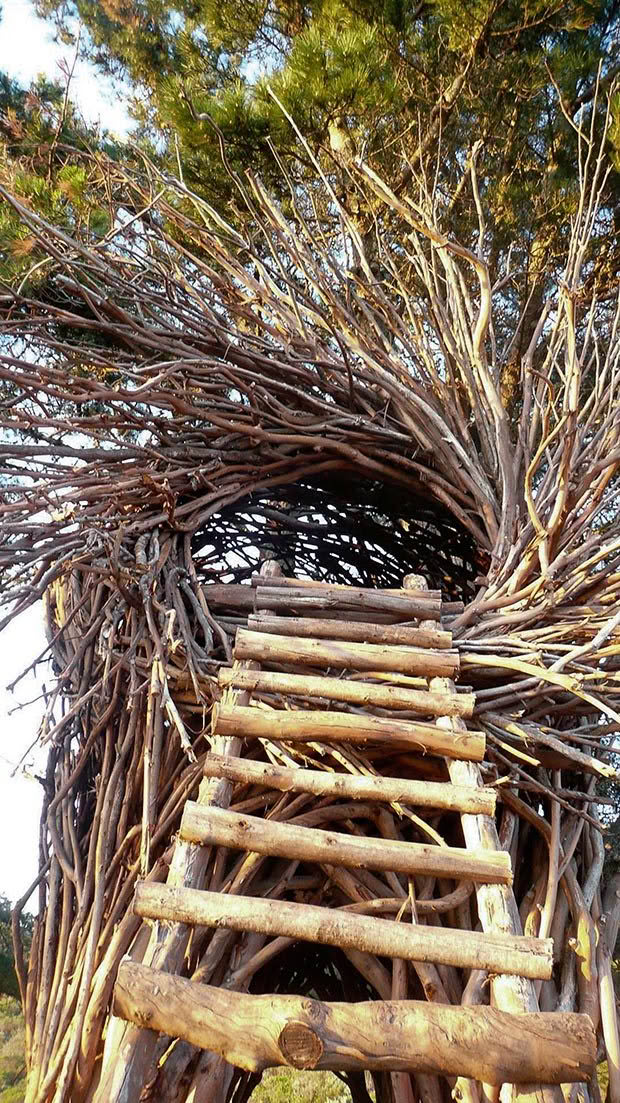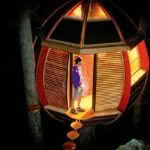Building a beautiful nest home (plus how to live through a renovation project)

The Human Nest
If you are creating or recreating your own little nest, Sara has some tips on how to survive the process.
Words: Sara Gerard
Sara is a landscape architect who lives with her family on a lifestyle block in Hawke’s Bay.
I was surfing the internet when I found what looked like a heavenly spot to go on holiday . It was a simple whorl of sticks around a double mattress up in a tree, with an oval entrance overlooking the huge expanse of Pacific Ocean.
I lay on my sofa and imagined myself dusting off the salt and dust from the mattress, sensing the sea breeze and speckled sunlight through the twigs, the ocean before me with all its immensity, the different lights and moods of the day, and then the sparkle of the moonlight on the ocean’s surface. After lying there for quite some time I could feel myself begin to soar.
Instead, our family holiday was spent at home. Two of us had the flu. My teenage daughter informed me family became naturally irritating when together for too long, so she departed to her most accessible nest (her bedroom).
This is our sixth year living on our lifestyle property but this is probably the first year I have been able to cherish it. Our 1920s bungalow farmhouse was rented out for 10 years before being subdivided off the main farm. We had builders and sub-contractors here for four and a half months to turn it into something we regarded as liveable. Internal walls were rebuilt, the flooring was restored, windows were found and installed, new plumbing and wiring went in, and it got a new bathroom, kitchen and laundry.
When we finally moved in on December 18, 2007, almost every surface of the house needed finishing in some way. We made a nest in the dining room and put up a Christmas tree.
Having a house that looked like a building site did not suit the perfectionist bent in my personality. At times I would find the work ahead of us overwhelming. For the first year or so I found it hard to get out of the car. The immediate view from the driveway was the pink primer paint on the exterior and it become a priority to lure me in. Another means of coping was to get my husband to set me tasks to distract my mind from the bigger renovation picture. The feeling of being overwhelmed is not helpful to anyone.

While we concentrated on the house, the garden and rest of the property took a backseat. The garden was composed of some old shrubby trees around a square perimeter and a vegetable garden. Most of it was on a slope with very little space for seating, let alone room to entertain.
We installed windows and doors out from the living areas on the north-east side of the house, excavated a flat area, and built decking out from the house. It was only a few months ago that we finally put in the lawns. The transition from mud and/or dust to a grass lawn has made the most difference to the place turning from being just a house into a home.
My nest now is the living room. It’s my favourite room, full of snoozing cats and dogs, lots of sun and gentle garden-to-farm views where I watch tui and other birds dart from one bush to another.

Sunset at The Human Nest.
I lie here in my nest and reflect. Nothing around me is perfect by any means but all the things around me are what I require in a good nest. It’s a matter of letting go of all the things that are to yet be done, surrounding myself with the simple things that make me feel good and rested. It’s time to enjoy being in the moment.
A NEW NEST PROJECT
One of those is to provide a nest for visitors. The concept has a real appeal for me as I have become fascinated with the ‘tiny house’ movement that is currently fashionable in the USA. People are choosing to move away from large homes and live within their means, debt-free, in homes that are as small as 10m².
I think my fascination is something to do with our honeymoon. We had 200 guests at our wedding, and we did much of the organising (and partying). Afterwards, in a state of exhaustion, we stayed in an amazing and tiny rustic cottage in Akaroa for our honeymoon. It had no electricity, an open fire and an outdoor bath. The extreme simplicity made it a wonderful place to rest and reflect.
For me, a nest to relax in requires simplicity and being quite close to nature, but an actual nest overlooking the ocean on a hot summer’s night would be the best of all!
THE HUMAN NEST

Sarah’s ‘nest’ is an unusual work of woven wood-art created and built by Big Sur artist Jayson Fann. The exclusive Human Nest offers guests an extreme ‘eco- sleep’ experience for US$175 a night.
The walk-in campsite on the California coastline includes private use of the wood-woven nest, a picnic table and nearby access to water. The nest itself has a wood ladder access, and a full-sized futon mattress perched inside it. You haul your own sleeping bags and pillows up the ladder to nestle in for the night, weather permitting.
The nest isn’t rain-proof so guests are advised to bring a tent just in case.
www.treebonesresort.com
14 TIPS FOR LIVING THOUGH A RENOVATION PROJECT

Costs
1. Carry out (or pay for) a full building inspection before you buy so you know what you are in for.
2. Choose an architect, engineer, landscaper, and other consultants who understand your budget, needs and wishes, and are able to communicate advice to you.
3. Understand council requirements. For us, in a high wind zone, the internal rimu sarking had to be replaced with metal bracing and gib for extra strength.
4. Be aware, once priced, that most renovations cost twice as much as the budget. Ensure the budget includes all the add-ons and periphery costs.
5. If you want services (driveway, paved exterior, lawns and garden areas) ensure that these are also priced.
Stress Reduction
6. Prioritise the areas that get you down or bug you the most.
7. Let your team practice their decorating skills on a back bedroom first. We did the bathroom first, and the paint is still too thin on the walls and ceiling!
8. If you have the budget, use professional tradespeople for the bathroom and kitchen.
9. Completely finish one room at a time.
10. For paint brush clean-up, instead of using the laundry (especially if you have a septic tank), install a paint clean-up area outside the house and have a lockable paint cupboard in the garage.
11. If you’re feeling overwhelmed, get someone else to set you manageable tasks to do, one at a time.
12. Take breaks away and time off.
13. Invite people around to entertain so that you get to have a tidy-up and appreciate all the hard work.
14. Sit back now and again in your nest and reflect on what has been achieved and how your nest has evolved!
CASE STUDY: THE HEMLOFT TREE HOUSE
The Hemloft
Designer/builder: Joel Allen
Size: 18m²
Site: Whistler,British Columbia
Building materials: recycled wood and materials
Value: CA$10,000 (NZ$11,000)
www.thehemloft.com
This is the dream ‘nest’ of Canadian software developer-turned-carpenter Joel Allen. His treehouse which he calls the Hemloft (its original site was in a forest of hemlock trees) was built from mostly recycled materials he found on Craigslist, a classified advertising website.
Joel spent months looking for the perfect tree which had to fit specific criteria: bare of lower branches and in proportion to what he wanted to build, within a reasonable distance of a road, yet out of sight and earshot of people, have a view (preferably with a south-westerly aspect), and be close to running water if possible. That perfect tree turned out to be in a public forest so the Hemloft was kept a secret during construction and for a couple of years afterward.

The final design was tested before construction began and broadened to become an egg-shape. It has a sleeping area, an outdoor deck and a work space. Only a few friends and family knew about it, until finally Joel confessed via an architecture magazine, meaning the Hemloft had to be moved. After a campaign to find it a new spot, a local adventure wilderness company got together the funds to move it about 10km down the road to its land where it will become part of its collection of visitor accommodation.
Thinking outside the box in a 60sqm container house (in cherry orchard)
Love this story? Subscribe now!
 This article first appeared in NZ Lifestyle Block Magazine.
This article first appeared in NZ Lifestyle Block Magazine.










